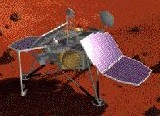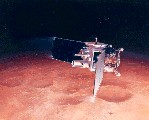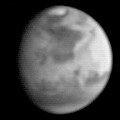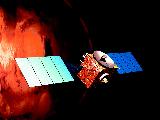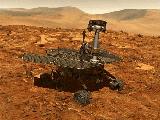This structured version of the Mars Link and Exploration page is still
under construction !
.. read on your own risk ..
![[HST views of Mars]](hst-mars.jpg) Sequence of Hubble Space Telescope images of Mars, showing Syrtis Major,
taken 1994-1995. Note the seasonal changes and varying distance effects.
Sequence of Hubble Space Telescope images of Mars, showing Syrtis Major,
taken 1994-1995. Note the seasonal changes and varying distance effects.
More HST images of Mars
Planet Mars, Mars Exploration and Mars Missions
This page is also
available in its original list format
Hottest links:
Mars, the Planet
Observing Mars
Mars Exploration
Toward a Crewed Mars Mission and Humans on Mars:
Resources
Link pages
Mars Missions
>>Current and Future Mars Missions
- Launch Sequence of all historic Mars missions
(and scheduled launch dates for future missions), with links to spacecraft
images and webpages
- Mars Exploration Program
(JPL; includes mirror index)
- Nasa's
Mars and Lunar Exploration Website (JSC);
Mars images and Mars ISRU Sample Return (MISR) mission
-
ON MARS - Exploration of the Red Planet 1958-1978 - NASA SP-4212
Edward Clinton Ezell & Linda Neuman Ezell - The NASA History Series -
Scientific and Technical Information Branch, 1984. NASA, W DC
- Mariner 4, first successful spacecraft to Mars in 1964:
Mariner IV - First Flyby of Mars, some personal experiences.
By Bill Momsen.
- Mariner 9, first Mars orbiter in 1971, mapped the whole planet:
Mariner 9 image browser (Peter Masek)
- Viking 1 & 2 spacecraft:
Most successful Orbiter-Lander pairs, lauched August/September 1975 and operated
in Mars orbit and on Mars surface since mid-1976.
Viking info, images and links at SEDS;
Viking homepage at Nasa's NSSDC;
Viking homepage at NASM;
Viking 1 & 2 info at JPL;
- Mars Observer spacecraft:
Launched September 1992, this spacecraft got lost on Mars Orbit Insertion in August
1993.
Images and information collected at SEDS;
Images from its interplanetary cruise
at Malin Space Science Systems
- Russian
Mars 96
(previously Mars 94) was launched on November 16, 1996, but failed to leave
Earth's orbit, and decayed shortly after liftoff.
- Mars Pathfinder (MPF) (previously named "MESUR" or "Pathfinder",
after landing renamed Carl Sagan Memorial Station)
and its rover Sojourner (previously Rocky IV, also MFEX rover):
Successful little Mars lander, lauched December 1996, operated in summer 1997.
- Mars Climate Orbiter (previously named Mars Surveyor 1998 Orbiter):
Launched December 1998, this spacecraft got lost on Mars Orbit Insertion.
- Mars Polar Lander (former Mars Surveyor 1998 Lander or
Mars Volatiles and Climate Surveyor (MVACS)):
Launched January 1999, this spacecraft got lost during descent to Mars surface.
Mars Polar Lander carried two small penetrators, Deep Space-2
(also got lost during descent):
Current and Future Missions:
Also look at the Launch Sequence of all historic
Mars missions (and scheduled launch dates for future missions)
Also note the older Mars Mission
schedule which was redefined after the failures of Mars Climate Orbiter
and Mars Polar Lander.
Launched in 1996:
-
Mars Global Surveyor
Mars orbiter, launched from KSC, Cape Canaveral on November 7, 1996,
9 a.m. EST. Reached Mars and successfully entered Mars orbit on
September 11, 1997; uses aerobraking for achieving the low Mars orbit
required for the intended orbital investigations of the Red Planet,
to begin in early 1998. Its mission is to survey Mars from orbit,
with instruments constructed for the lost Mars Observer.
Moreover, it should serve as relay for the lander missions Mars Pathfinder,
and was intended to supplement unlucky Mars 96.
Launched 1998-99:
- Japan's Nozomi (for Hope; former Planet B)
Mars orbiter was successfully launched on July 4, 1998 with a M-V-3
rocket, and flew 2 Lunar swingbys on September 24 and on December 18,
1998, and one Earth swingby on December 20, 1998. It was scheduled to
arrive at Mars on October 11, 1999, but due to "insufficient acceleration"
in its Earth flyby and consequent course correction, its Mars encouter
was delayed by more than 4 years to January 2004.
It is to study Mars' upper atmosphere.
Planet-B image [158k gif];
Nozomi information, images and links
from SEDS;
Planet B Mars orbiter homepage
Launched 2001:
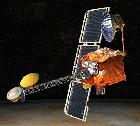
|
- 2001 Mars Odyssee, Mars Surveyor 2001 orbiter was
successfully launched on April 7, 2001 from Cape Canaveral with a Delta II
rocket, arrived at Mars after an over 6 month interplanetary cruise, and
was successfully inserted into Mars orbit on October 24, 2001 (see
Mars Orbit Insertion (MOI) information).
The spacecraft has now entered the phase of
aerobraking in order to lower its initial highly-excentric orbit.
It is intended to test aerocapture techniques (down to 120 km
above Martian surface !) for achieving its circular 400 km Polar orbit after
periapsis lifts. If this goes well, it will conduct science from orbit,
its primary science mission covering the time of January, 2002 through July,
2004. This Mars orbiter mission is to perform the research originally
scheduled for the lost Mars Climate Orbiter (Mars Surveyor 1998 Orbiter),
i.e., Mars wheather and climate.
Scientific investigations will be including mineralogical mapping and
radiation measurements, with its main instruments GRS (Gamma Ray Spectrometer)
from Mars Observer, THEMIS (Thermal Emission Imaging System) which is
developed under the direction of ASU, and MARIE (Mars Radiation Environment
Experiment). The spacecraft is also to serve as communications relay for
future Mars landers.
Launched 2003:
- Mars Express (ESA).
Launched on June 2, 2003 with a Russian Soyuz/Fregat rocket.
Orbiter and lander "Beagle 2".
- Spirit, 2003 Mars Exploration Rover 2, MER-2,
Mars Exploration Rover A, MER-A,
Mars Surveyor 2003 Lander/Rover A: First of two Nasa sister spacecraft
(the other is Mars Surveyor 2003 Lander/Rover B or 2), successfully launched on
June 10, 2003, with a Delta 2 (7425). This mission was redefined and now
omits a stationary lander, which was to contain imaging system and various
instruments to study radiation and soil. Instead, it consists of a large
rover (Athena, ~130 kg)) which is to land similar to Mars Pathfinder in
direct approach and airbag buffered. It is to investigate samples from a
10 km range around the landing site, with a sampling arm and store and
investigate it. Originally, Athena was to load the samples into a soccer
ball-sized container, which would have been blasted into orbit around Mars
and picked up and delivered back to Earth by a later mission.
Landing scheduled for January , 2004.
The lander should investigate the landing site region for at least 90 days.
- Opportunity, 2003 Mars Exploration Rover 1, MER-1,
Mars Exploration Rover B, MER-B,
Mars Surveyor 2003 Lander/Rover B:
Nasa successfully launched this second of two sister spacecraft (the other is
Mars Exploration Rover (MER) 2 or A) on July 7, 2003, with a Delta 2 (7425).
It is to be landed using an airbag system, without stationary lander. Landing
scheduled for January 25, 2004. The lander should investigate the landing
site region for at least 90 days. This mission, after being redefined, now
omits a stationary lander, but consists of a large ~130 kg rover (Athena)
only. It is to land similar to Mars Pathfinder in direct approach and airbag
buffered. It is to investigate samples from a 10 km range around the landing
site, with a sampling arm, and store and investigate it.
Originally, Athena was to load the samples into a soccer ball-sized container,
which would have been blasted into orbit around Mars and picked up and delivered
back to Earth by a later mission.
To be launched 2004 or 2005:
- Rosetta: Was intended as ESA's Mars, Asteroid and Comet
mission, and was scheduled to be launched in January, 2003 by Ariane 5.
To achieve its more distant targets, it was to take a gravity assist
during Mars flyby on August 25, 2006. It would fly on and pass Earth
twice and two asteroids each once, before it had reached Comet Wirtanen
in August 2011, and finally landed on it one year later.
Because of problems with the Ariane 5 launcher, ESA has postponed the
Rosetta mission to 2004 or 2005, and there will be another redesigned
mission scenario, which may or may not include a Mars flyby.
Rosetta homepage at ESOC/ESA
To be launched 2005:
- Mars Reconnaissance Orbiter, Mars Surveyor 2005 Orbiter
(France).
To be launched on August 10, 2005 by an Atlas V rocket, and to arrive at
Mars in March, 2006.
To study Mars from orbit during its science mission from March 2006 to
July 2008, perform high-resolution measurements including images with a
resolution of 20 to 30 cm, and possibly serve as communications relay for
later Mars landers until about February 2010.
To be launched 2007:
- Mars 2007 Remote Sensing Orbiter (CNES, French Space Agency),
scheduled for launch in late 2007.
Remote Sensing Orbiter.
Mars 2003 and 2005 page (NSSDC)
- Mars 2007 Netlander (CNES, French Space Agency),
scheduled for launch with an Ariane 5 in late 2007.
Network of 4 small landers to perform scientific measurements on the surface of
Mars over one Martian year.
Netlander homepage;
Mars 2003 and 2005 page (NSSDC)
- Mars 2007 Communications Orbiter (ASI, Italian Space Agency),
scheduled for launch in late 2007.
Communications orbiter for Netlanders and future missions.
Mars 2003 and 2005 page (NSSDC)
- Mars 2007 Small Scout Missions (Nasa), tentatively scheduled for launch
in December 2006, arrival at Mars February, 2009, science mission February to
August, 2009.
One or more of a series of small "scout" missions, including small landers,
airplanes and balloons.
Nasa Press Release 02-238 of Dec 6, 2002,
Solar System Exploration: Missions: Mars: Mars Scout (JPL),
Mars 2003 and 2005 page (NSSDC),
2005 and Beyond (JPL)
The proposed mission selected for study are:
To be launched 2009:
- Mars Smart Lander, Mars 2009 Mobile Scientific Laboratory
(Nasa), formerly scheduled for 2007.
To be launched in late 2009, land on Mars in mid 2010, and perform a 2-year
science mission.
Long-range, long-duration rover equipped to perform many scientific studies
of Mars, and to demonstrate the technology for accurate landing and hazard
avoidance in order to travel to difficult-to-reach sites.
Smart Lander page (JPL),
Mars 2003 and 2005 page (NSSDC),
2005 and Beyond (JPL)
- Mars 2009 Communications Satellite (Nasa, Italy).
Under study for launch in late 2009. Possible Communications Satellite.
Mars 2003 and 2005 page (NSSDC),
2005 and Beyond (JPL)
- Mars 2009 Small Net-Landers (Nasa, France).
Under study for launch n late 2009. Possible Small Net-Landers.
Mars 2003 and 2005 page (NSSDC),
2005 and Beyond (JPL)
To be launched 2011:
- Mars 2011, Mars Sample Return Lander (Nasa, France,
international?),
under study for launch in late 2011. Possible first sample return mission.
To arrive at Mars in September 2012, launch from Mars December 2012, and
return to Earth in September, 2014.
Solar System Exploration: Missions: Mars: Sample Return Lander (JPL),
Mars 2003 and 2005 page (NSSDC),
2005 and Beyond (JPL)
- Mars Scout 2 (Nasa).
A mission succeeding and extending the 2007 Mars Scout.
Solar System Exploration: Missions: Mars: Scout 2 (JPL),
Mars 2003 and 2005 page (NSSDC),
2005 and Beyond (JPL)
To be launched 2014:
To be launched 2016:
Note: Some missions are still in the early planning stage.
For the time after 2016, a continuation of the research missions is planned.
Detailed plans are still to be worked out, and should utilize the newly acquired
knowledge of the current and scheduled Mars missions.
Nasa officials have expressed their intention that these efforts should
eventually be leading to a Mars mission with a human crew to be launched in
2018 (and to arrive at Mars in 2019), and to begin an era of permanent human
presence on our neighbor planet.
Moreover, this date is continuously under discussion with the aim to do
the mission sooner (The earliest (now outdated) proposition was a crewed
mission as early as 2007, while CNN has reported
plans for a crewed mission in 2012 !)
A Crewed Mission to Mars ... Scenario (NSSDC),
after NASA Special Publication #6107
Comments, corrections, and propositions to this page are welcome !
Contact me !
Hartmut Frommert
[contact]
![[Spider] @](../Jco/spider.ico.jpg)
![[SEDS]](../Jco/seds.jpg)
Last Modification: August 11, 2005
![[HST views of Mars]](hst-mars.jpg)
![[HST views of Mars]](hst-mars.jpg)


